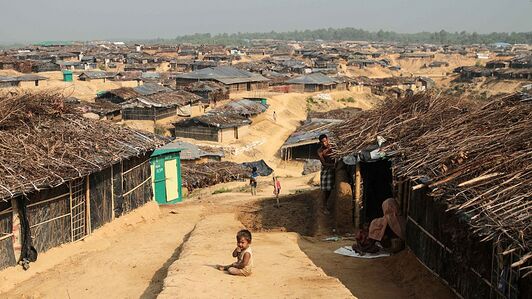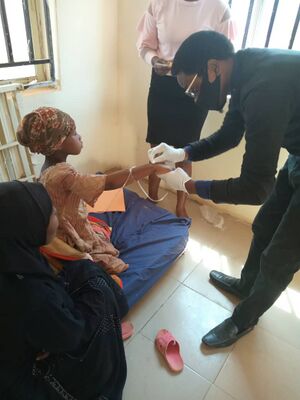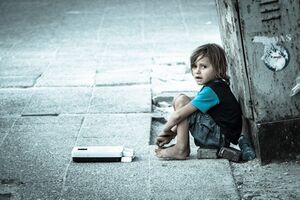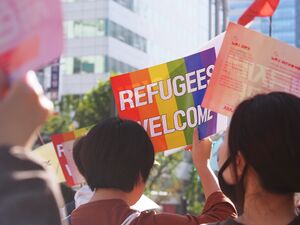Health Concerns for Displaced Persons: Difference between revisions
No edit summary |
No edit summary |
||
| (44 intermediate revisions by 7 users not shown) | |||
| Line 1: | Line 1: | ||
<div class="editorbox"> | <div class="editorbox"> | ||
'''Original Editor '''- [[User: | '''Original Editor '''- [[User:Nimisha Gorasia|Nimisha Gorasia]], [[User:Ayman Baroudi|Ayman Baroudi]], [[User:Chidera Lilian|Chidera Lilian]] as part of the [[PREP Content Development Project|PREP Content Development Project]] | ||
'''Top Contributors''' - {{Special:Contributors/{{FULLPAGENAME}}}} | '''Top Contributors''' - {{Special:Contributors/{{FULLPAGENAME}}}} | ||
</div | </div> | ||
== Introduction == | == Introduction == | ||
[[File:Refugee Camp (John Owens-VOA).jpeg|right|frameless|532x532px]] | |||
Around 83.9 million people worldwide are currently displaced, with 30.7 million of them crossing international boundaries in search of protection. Migrants and refugees are likely to have good general health initially. However, they can be at risk of falling sick in transition or whilst staying in receiving countries due to poor living conditions or adjustments in their lifestyle.<ref name=":2">WHO [https://www.who.int/news-room/feature-stories/detail/10-things-to-know-about-the-health-of-refugees-and-migrants 10 things to know about the health of refugees and migrants] Available:https://www.who.int/news-room/feature-stories/detail/10-things-to-know-about-the-health-of-refugees-and-migrants Accessed 2.9.2021</ref> | |||
< | |||
The physical, psychological and social experiences of a person fleeing conflict and persecution and seeking safety are referred to as displaced person experiences.<ref>Ministry of Health. Refugee Health Care: A handbook for health professionals. Wellington: Ministry of Health. 2012</ref> There is an increased risk of health problems among individuals who have been displaced as they are faced with mental and physical stress both in their home countries and during the migration process.<ref>Palic S, Elklit A. An explorative outcome study of CBT-based multidisciplinary treatment in a diverse group of refugees from a Danish treatment centre for rehabilitation of traumatized refugees. Torture.2009. 19; 3:248-270. | |||
</ref><ref>Razavi MF, Falk L, Björn Å, Wilhelmsson S. Experiences of the Swedish healthcare system: an interview study with refugees in need of long-term health care. Scandinavian Journal of Public Health. 2011. 39; 3:319-325.</ref> | |||
< | |||
Some key points: | |||
* Immigrant populations are large and heterogeneous, resulting in a wide variety of health situations. | |||
* | * Migration itself is not considered a risk factor for illness, and migrants have in general fewer health problems than the population both in their home country and in their new country. However, forced migration is a completely different situation, and it is very important to acknowledge this difference. | ||
* | * People with experience of displacement are at risk of complex physical, mental and social problems, which can contribute to poor health outcomes and impede successful social integration. | ||
* | * Forced migration has a massive impact on the lives of displaced persons causing issues such as [[depression]], anxiety, [[Post-traumatic Stress Disorder|post-traumatic stress disorder]], [[Sleep Deprivation and Sleep Disorders|sleeping problems]], [[Respiratory Disorders|respiratory]] and digestive [[Infectious Disease|infections]], among others. | ||
* | * Individuals who have experienced displacement can struggle to find a sense of belonging or social recognition. They may also have difficulty developing trust and confidence and maintaining motivation when trying to adapt to their new circumstances. Similarly, they may experience financial and social disadvantages, communication difficulties due to cultural and language differences, instability and constant fear of being deported. All of these factors can have an impact on health. | ||
* | * A significant proportion of displaced persons have been subjects to severe physical and/or psychological torture. This exposure may have long-term physical and psychological consequences. | ||
== Problems and Stressors Facing Displaced Persons == | |||
Displaced persons often face various problems and stressors which can take place at various stages of the migration process: | |||
# '''Pre-migration:''' | |||
#* Lack of livelihoods and opportunities for education and development, exposure to armed conflict, violence, poverty and/or persecution. | |||
# '''Migration travel and transit:''' | |||
#* Exposure to challenging and life-threatening conditions including violence and detention and lack of access to services to cover their basic needs. | |||
# '''Post-migration:''' | |||
#* Barriers to accessing health care and other services to meet their basic needs as well as poor living conditions, separation from family members and support networks, possible uncertainty regarding work permits and legal status (asylum application), and in some cases immigration detention. | |||
# '''Integration and settlement:''' | |||
#* Poor living or working conditions, unemployment, assimilation difficulties, challenges to cultural, religious, and gender identities, challenges with obtaining entitlements, changing policies in host countries, racism and exclusion, tension between host population and migrants and refugees, social isolation and possible deportation. | |||
== Impact of Migration on Health == | |||
[[File:Health Service for refugees.jpeg|right|frameless]] | |||
Migration can and does have a significant impact on displaced persons. Significant issues include: | |||
* Exposure to communicable diseases | |||
* Declining vaccination rates for communicable diseases and issues such as coverage, reliable records etc.<ref>Mipatrini D, Stefanelli P, Severoni S, Rezza G. [https://www.ncbi.nlm.nih.gov/pmc/articles/PMC5375618/ Vaccinations in migrants and refugees: a challenge for European health systems. A systematic review of current scientific evidence]. Pathog Glob Health. 2017 Mar;111(2):59-68.</ref> | |||
* Health vulnerability i.e. the extent to which the individual (in this case, a migrant) can live with the anticipation of, cope with, resist and recover from the impact of disease, in particular [[Endemics, Epidemics and Pandemics|pandemics]].<ref name=":1">Stewart M, Makwarimba E, Beiser M, Neufeld A, Simich L, Spitzer D. Social support and health: immigrants’ and refugees’ perspectives. Diversity in Health and Care. 2010;7(2):91-103.</ref> | |||
** Socioeconomic status impacts health vulnerability | |||
* The fear / experience of isolation, insecurity, long journeys<ref name=":1" /> | |||
== Challenges in Accessing Health Care == | |||
Because of factors such as a migrant's legal status, language barriers and discrimination, some national health strategies may not make any reference to the health of displaced persons or the accessibility of health care for them. The World Health Organization calls on every country to implement policies that provide health care services to all migrants and displaced persons, irrespective of their legal status.<ref name=":2" /> | |||
== Major Health Concerns == | |||
[[File:Refugee.jpeg|right|frameless]]Displaced persons can experience many different health and psychosocial issues:<ref>Ackerman LK. Health problems of refugees. [https://pubmed.ncbi.nlm.nih.gov/9297659/ The Journal of the American Board of Family Practic]e. 1997 Sep 1;10(5):337-48.Available : https://pubmed.ncbi.nlm.nih.gov/9297659/ (accessed 2.9.2021)</ref> | |||
*[[Non-Communicable Diseases|Non-Communicable Diseases (NCD)]] | |||
** Also termed [[Chronic Disease|chronic diseases]]. They are collectively responsible for 71% of all deaths worldwide.<ref>Noncommunicable diseases, WHO, 1 June 2018 [http://www.who.int/news-room/fact-sheets/detail/noncommunicable-diseases<nowiki>]</nowiki></ref> Almost 75% of all deaths caused by NCD occur in low- and middle-income countries.<ref name="WHO">WHO. Noncommunicable diseases and their risk factors http://www.who.int/ncds/en/ accessed 15 July 2016</ref> | |||
** NCDs also account for 48% of the healthy life years lost worldwide versus 40% for communicable diseases, maternal and perinatal conditions and nutritional deficiencies, and 1% for injuries<ref name="GBD">Bloom, D.E., Cafiero, E.T., Jané-Llopis, E., Abrahams-Gessel, S., Bloom, L.R., Fathima, S., Feigl, A.B., Gaziano, T., Mowafi, M., Pandya, A., Prettner, K., Rosenberg, L., Seligman, B., Stein, A.Z., & Weinstein, C. (2011). The Global Economic Burden of Noncommunicable Diseases. Geneva: World Economic Forum</ref> | |||
***[[:Category:Oncology|Cancer:]] Aside from cervical cancer, displaced persons have a lower risk for all forms of cancer. "However, cancer is more likely to be diagnosed at an advanced stage in persons who are displaced, which can lead to considerably worse health outcomes compared with the host population"<ref name=":2" /> | |||
***[[Cardiovascular Disease|Cardiovascular disease]] | |||
***[[:Category:Chronic Respiratory Disease|Chronic respiratory disease]] | |||
***[[Diabetes|Diabetes:]] Displaced persons have a higher incidence, prevalence and mortality rate for diabetes than their host population<ref name=":2" /> | |||
*[[Communicable Diseases|Communicable diseases]] | |||
**[[Tuberculosis]] | |||
**[[Hepatitis A, B, C|Hepatitis]] | |||
**[[Human Immunodeficiency Virus (HIV)]] | |||
**[[Parasitic Infections|Parasitic infections]]: | |||
***[[Malaria]] | |||
*** Giardiasis | |||
*** Leishmaniasis | |||
*[[Mental Health and Forced Displacement|Mental health]] | |||
**[[Post-traumatic Stress Disorder|Post-traumatic stress disorder (PTSD)]] appears to be more common among displaced persons than their host population<ref name=":2" /> | |||
**[[Depression]] is a common illness worldwide, with more than 264 million people affected. It is commonly reported in displaced persons, particularly in those who have lengthy asylum-seeking processes and who live in poor socioeconomic conditions (e.g. unemployment or isolation).<ref name=":2" /> | |||
**[[Generalized Anxiety Disorder|Generalised anxiety disorder]] is one of the most common mental health disorders affecting up to 20% of the adult population worldwide. It produces fear, worries, and a constant feeling of being overwhelmed. Generalised anxiety disorder is often characterised by persistent, excessive, and unrealistic worry about everyday things. It is commonly reported/linked to lengthy asylum-seeking processes and poor socioeconomic conditions, such as unemployment or isolation.<ref name=":2" /> | |||
* Pelvic pain and dysfunction | |||
* Musculoskeletal injury | |||
** Displaced persons encounter frequent falls during the migration process. Fractures are one of the most prevalent injuries caused by trauma in displaced persons.<ref>Yigit Duzkoylu, Salim Ilksen Basceken and Emrullah Cem Kesilmez. Physical Trauma among Refugees: Comparison between Refugees and Local Population Who Were Admitted to Emergency Department—Experience of a State Hospital in Syrian Border District. Journal of environmental and Public Health. 2017. https://doi.org/10.1155/2017/8626275 | |||
</ref> | |||
*[[Burns Overview|Burns]] | |||
** According to the World Health Organization, a [[Burns Overview|burn]] is an injury to the skin or other organic tissue primarily caused by heat (hot liquids, hot solids and flames) or due to radiation, radioactivity, electricity, friction or contact with chemicals. This is one of the most common health conditions seen in displaced persons. It becomes life-threatening, especially in very young and very old individuals. Due to pain and discomfort, the individuals tend to keep their body in a position of comfort, thus encouraging joint contractures and [[Pressure Ulcers|pressure sore]] formation.<ref>Van Hasselt, EJ. BURNS MANUAL.A manual for health workers.2018 2nd edition. pg 51.</ref> | |||
*[[Spinal Cord Injury]] | |||
**Significant life-changing injury seen in war, conflict or disaster injuries experienced by displaced.<ref>Hermansson AC, Thyberg M, Timpka T. War-wounded refugees: the types of injury and influence of disability on well-being and social integration. Med Confl Surviv. 1996; 12(4):284-302. doi:10.1080/13623699608409299 | |||
</ref> For war-injured displaced persons, spinal cord injury (SCI) is a leading cause of catastrophic neurologic injury, with evidence focused on the care of this vulnerable population. There are multiple challenges in caring for displaced persons with SCI in low and middle-income countries where most displaced persons are based. An interdisciplinary SCI rehabilitation approach can provide comprehensive care for this vulnerable population.<ref>Jones MW, Crane DA. [https://pubmed.ncbi.nlm.nih.gov/32345983/ Interdisciplinary care for spinal cord injured refugees.] Spinal cord series and cases. 2020 Apr 28;6(1):1-3.Available: https://pubmed.ncbi.nlm.nih.gov/32345983/ (accessed 2.9.2021)</ref> | |||
* Unaccompanied Children or Orphaned Children | |||
** Children without parents or a guardian are especially vulnerable and at risk for both health and social problems. They risk for "abduction and trafficking for sale and exploitation can be exacerbated if border controls are weak, violations of children’s rights already exist and there is easy access to the child. Children are also vulnerable to sexual exploitation and experience higher rates of depression and symptoms of post-traumatic stress disorder."<ref name=":2" /> | |||
* Occupational health, job status or unemployment. | |||
* | |||
* | |||
== | == Role of Rehabilitation Services == | ||
[[File:Refugees welcome.jpeg|right|frameless]]Refugee populations are likely to present with a series of complex and complicated health and wellness issues, including impairments, activity limitations, and participation restrictions. Landry et al.<ref>Landry MD, van Wijchen J, Jalovcic D, Boström C, Pettersson A, Alme MN. Refugees and Rehabilitation: Our Fight Against the “Globalization of Indifference”. Archives of physical medicine and rehabilitation. 2020 Jan 1;101(1):168-70.</ref> describe the following: | |||
== References | # Pre-existing disability and physical limitation | ||
# Underlying health conditions in the older adult | |||
# Post-migration and displacement health conditions | |||
<br>The rehabilitation professional plays a role when health problems cause pain, or limit the function of displaced persons either in their country of origin or during the migration process and are involved in: | |||
* Promoting optimal mobility, [[Physical Activity|physical activity]] and overall health and wellness | |||
* Preventing disease, injury, and disability | |||
* Managing acute and chronic conditions, activity limitations, and participation restrictions | |||
* Improving and maintaining optimal functional independence and physical performance | |||
* Rehabilitating injury and the effects of disease or disability with [[Therapeutic Exercise|therapeutic exercise]] programmes and other interventions | |||
* Educating and planning maintenance and support programmes to prevent re-occurrence, re-injury or functional decline | |||
== References == | |||
<references /> | <references /> | ||
[[Category:PREP Content Development Project]] | [[Category:PREP Content Development Project]] | ||
[[Category: | [[Category:Displaced Persons]] | ||
Latest revision as of 07:30, 30 April 2023
Original Editor - Nimisha Gorasia, Ayman Baroudi, Chidera Lilian as part of the PREP Content Development Project
Top Contributors - Naomi O'Reilly, Lucinda hampton, Kim Jackson, Jess Bell, Ewa Jaraczewska, Aminat Abolade and Carin Hunter
Introduction[edit | edit source]
Around 83.9 million people worldwide are currently displaced, with 30.7 million of them crossing international boundaries in search of protection. Migrants and refugees are likely to have good general health initially. However, they can be at risk of falling sick in transition or whilst staying in receiving countries due to poor living conditions or adjustments in their lifestyle.[1]
The physical, psychological and social experiences of a person fleeing conflict and persecution and seeking safety are referred to as displaced person experiences.[2] There is an increased risk of health problems among individuals who have been displaced as they are faced with mental and physical stress both in their home countries and during the migration process.[3][4]
Some key points:
- Immigrant populations are large and heterogeneous, resulting in a wide variety of health situations.
- Migration itself is not considered a risk factor for illness, and migrants have in general fewer health problems than the population both in their home country and in their new country. However, forced migration is a completely different situation, and it is very important to acknowledge this difference.
- People with experience of displacement are at risk of complex physical, mental and social problems, which can contribute to poor health outcomes and impede successful social integration.
- Forced migration has a massive impact on the lives of displaced persons causing issues such as depression, anxiety, post-traumatic stress disorder, sleeping problems, respiratory and digestive infections, among others.
- Individuals who have experienced displacement can struggle to find a sense of belonging or social recognition. They may also have difficulty developing trust and confidence and maintaining motivation when trying to adapt to their new circumstances. Similarly, they may experience financial and social disadvantages, communication difficulties due to cultural and language differences, instability and constant fear of being deported. All of these factors can have an impact on health.
- A significant proportion of displaced persons have been subjects to severe physical and/or psychological torture. This exposure may have long-term physical and psychological consequences.
Problems and Stressors Facing Displaced Persons[edit | edit source]
Displaced persons often face various problems and stressors which can take place at various stages of the migration process:
- Pre-migration:
- Lack of livelihoods and opportunities for education and development, exposure to armed conflict, violence, poverty and/or persecution.
- Migration travel and transit:
- Exposure to challenging and life-threatening conditions including violence and detention and lack of access to services to cover their basic needs.
- Post-migration:
- Barriers to accessing health care and other services to meet their basic needs as well as poor living conditions, separation from family members and support networks, possible uncertainty regarding work permits and legal status (asylum application), and in some cases immigration detention.
- Integration and settlement:
- Poor living or working conditions, unemployment, assimilation difficulties, challenges to cultural, religious, and gender identities, challenges with obtaining entitlements, changing policies in host countries, racism and exclusion, tension between host population and migrants and refugees, social isolation and possible deportation.
Impact of Migration on Health[edit | edit source]
Migration can and does have a significant impact on displaced persons. Significant issues include:
- Exposure to communicable diseases
- Declining vaccination rates for communicable diseases and issues such as coverage, reliable records etc.[5]
- Health vulnerability i.e. the extent to which the individual (in this case, a migrant) can live with the anticipation of, cope with, resist and recover from the impact of disease, in particular pandemics.[6]
- Socioeconomic status impacts health vulnerability
- The fear / experience of isolation, insecurity, long journeys[6]
Challenges in Accessing Health Care[edit | edit source]
Because of factors such as a migrant's legal status, language barriers and discrimination, some national health strategies may not make any reference to the health of displaced persons or the accessibility of health care for them. The World Health Organization calls on every country to implement policies that provide health care services to all migrants and displaced persons, irrespective of their legal status.[1]
Major Health Concerns[edit | edit source]
Displaced persons can experience many different health and psychosocial issues:[7]
- Non-Communicable Diseases (NCD)
- Also termed chronic diseases. They are collectively responsible for 71% of all deaths worldwide.[8] Almost 75% of all deaths caused by NCD occur in low- and middle-income countries.[9]
- NCDs also account for 48% of the healthy life years lost worldwide versus 40% for communicable diseases, maternal and perinatal conditions and nutritional deficiencies, and 1% for injuries[10]
- Cancer: Aside from cervical cancer, displaced persons have a lower risk for all forms of cancer. "However, cancer is more likely to be diagnosed at an advanced stage in persons who are displaced, which can lead to considerably worse health outcomes compared with the host population"[1]
- Cardiovascular disease
- Chronic respiratory disease
- Diabetes: Displaced persons have a higher incidence, prevalence and mortality rate for diabetes than their host population[1]
- Communicable diseases
- Tuberculosis
- Hepatitis
- Human Immunodeficiency Virus (HIV)
- Parasitic infections:
- Malaria
- Giardiasis
- Leishmaniasis
- Mental health
- Post-traumatic stress disorder (PTSD) appears to be more common among displaced persons than their host population[1]
- Depression is a common illness worldwide, with more than 264 million people affected. It is commonly reported in displaced persons, particularly in those who have lengthy asylum-seeking processes and who live in poor socioeconomic conditions (e.g. unemployment or isolation).[1]
- Generalised anxiety disorder is one of the most common mental health disorders affecting up to 20% of the adult population worldwide. It produces fear, worries, and a constant feeling of being overwhelmed. Generalised anxiety disorder is often characterised by persistent, excessive, and unrealistic worry about everyday things. It is commonly reported/linked to lengthy asylum-seeking processes and poor socioeconomic conditions, such as unemployment or isolation.[1]
- Pelvic pain and dysfunction
- Musculoskeletal injury
- Displaced persons encounter frequent falls during the migration process. Fractures are one of the most prevalent injuries caused by trauma in displaced persons.[11]
- Burns
- According to the World Health Organization, a burn is an injury to the skin or other organic tissue primarily caused by heat (hot liquids, hot solids and flames) or due to radiation, radioactivity, electricity, friction or contact with chemicals. This is one of the most common health conditions seen in displaced persons. It becomes life-threatening, especially in very young and very old individuals. Due to pain and discomfort, the individuals tend to keep their body in a position of comfort, thus encouraging joint contractures and pressure sore formation.[12]
- Spinal Cord Injury
- Significant life-changing injury seen in war, conflict or disaster injuries experienced by displaced.[13] For war-injured displaced persons, spinal cord injury (SCI) is a leading cause of catastrophic neurologic injury, with evidence focused on the care of this vulnerable population. There are multiple challenges in caring for displaced persons with SCI in low and middle-income countries where most displaced persons are based. An interdisciplinary SCI rehabilitation approach can provide comprehensive care for this vulnerable population.[14]
- Unaccompanied Children or Orphaned Children
- Children without parents or a guardian are especially vulnerable and at risk for both health and social problems. They risk for "abduction and trafficking for sale and exploitation can be exacerbated if border controls are weak, violations of children’s rights already exist and there is easy access to the child. Children are also vulnerable to sexual exploitation and experience higher rates of depression and symptoms of post-traumatic stress disorder."[1]
- Occupational health, job status or unemployment.
Role of Rehabilitation Services[edit | edit source]
Refugee populations are likely to present with a series of complex and complicated health and wellness issues, including impairments, activity limitations, and participation restrictions. Landry et al.[15] describe the following:
- Pre-existing disability and physical limitation
- Underlying health conditions in the older adult
- Post-migration and displacement health conditions
The rehabilitation professional plays a role when health problems cause pain, or limit the function of displaced persons either in their country of origin or during the migration process and are involved in:
- Promoting optimal mobility, physical activity and overall health and wellness
- Preventing disease, injury, and disability
- Managing acute and chronic conditions, activity limitations, and participation restrictions
- Improving and maintaining optimal functional independence and physical performance
- Rehabilitating injury and the effects of disease or disability with therapeutic exercise programmes and other interventions
- Educating and planning maintenance and support programmes to prevent re-occurrence, re-injury or functional decline
References[edit | edit source]
- ↑ 1.0 1.1 1.2 1.3 1.4 1.5 1.6 1.7 WHO 10 things to know about the health of refugees and migrants Available:https://www.who.int/news-room/feature-stories/detail/10-things-to-know-about-the-health-of-refugees-and-migrants Accessed 2.9.2021
- ↑ Ministry of Health. Refugee Health Care: A handbook for health professionals. Wellington: Ministry of Health. 2012
- ↑ Palic S, Elklit A. An explorative outcome study of CBT-based multidisciplinary treatment in a diverse group of refugees from a Danish treatment centre for rehabilitation of traumatized refugees. Torture.2009. 19; 3:248-270.
- ↑ Razavi MF, Falk L, Björn Å, Wilhelmsson S. Experiences of the Swedish healthcare system: an interview study with refugees in need of long-term health care. Scandinavian Journal of Public Health. 2011. 39; 3:319-325.
- ↑ Mipatrini D, Stefanelli P, Severoni S, Rezza G. Vaccinations in migrants and refugees: a challenge for European health systems. A systematic review of current scientific evidence. Pathog Glob Health. 2017 Mar;111(2):59-68.
- ↑ 6.0 6.1 Stewart M, Makwarimba E, Beiser M, Neufeld A, Simich L, Spitzer D. Social support and health: immigrants’ and refugees’ perspectives. Diversity in Health and Care. 2010;7(2):91-103.
- ↑ Ackerman LK. Health problems of refugees. The Journal of the American Board of Family Practice. 1997 Sep 1;10(5):337-48.Available : https://pubmed.ncbi.nlm.nih.gov/9297659/ (accessed 2.9.2021)
- ↑ Noncommunicable diseases, WHO, 1 June 2018 [http://www.who.int/news-room/fact-sheets/detail/noncommunicable-diseases]
- ↑ WHO. Noncommunicable diseases and their risk factors http://www.who.int/ncds/en/ accessed 15 July 2016
- ↑ Bloom, D.E., Cafiero, E.T., Jané-Llopis, E., Abrahams-Gessel, S., Bloom, L.R., Fathima, S., Feigl, A.B., Gaziano, T., Mowafi, M., Pandya, A., Prettner, K., Rosenberg, L., Seligman, B., Stein, A.Z., & Weinstein, C. (2011). The Global Economic Burden of Noncommunicable Diseases. Geneva: World Economic Forum
- ↑ Yigit Duzkoylu, Salim Ilksen Basceken and Emrullah Cem Kesilmez. Physical Trauma among Refugees: Comparison between Refugees and Local Population Who Were Admitted to Emergency Department—Experience of a State Hospital in Syrian Border District. Journal of environmental and Public Health. 2017. https://doi.org/10.1155/2017/8626275
- ↑ Van Hasselt, EJ. BURNS MANUAL.A manual for health workers.2018 2nd edition. pg 51.
- ↑ Hermansson AC, Thyberg M, Timpka T. War-wounded refugees: the types of injury and influence of disability on well-being and social integration. Med Confl Surviv. 1996; 12(4):284-302. doi:10.1080/13623699608409299
- ↑ Jones MW, Crane DA. Interdisciplinary care for spinal cord injured refugees. Spinal cord series and cases. 2020 Apr 28;6(1):1-3.Available: https://pubmed.ncbi.nlm.nih.gov/32345983/ (accessed 2.9.2021)
- ↑ Landry MD, van Wijchen J, Jalovcic D, Boström C, Pettersson A, Alme MN. Refugees and Rehabilitation: Our Fight Against the “Globalization of Indifference”. Archives of physical medicine and rehabilitation. 2020 Jan 1;101(1):168-70.










